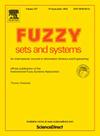“d分数”为二类模糊数,包含了快速思维与慢速思维的互动
IF 2.7
1区 数学
Q2 COMPUTER SCIENCE, THEORY & METHODS
引用次数: 0
摘要
模拟人类的思维过程在决策中是必不可少的。根据双过程理论,大脑中的快速思维和慢速思维会影响我们的判断和决定。2型模糊数(T2FN)用这两种思维模式来模拟塑造过程。然而,如何对它们之间的互动进行建模是一个谜,这可以称为互动思维。在本文中,我们提出了T2FN的d分数来揭示它们的相互作用机制,其中用相互作用系数θ来衡量它们的相互作用。这个分数描述了快速和缓慢的思维模式以及它们之间的转换过程,以及这种互动如何帮助决策者做出更好的决策。我们提出了两个优化模型来求解系数θ。通过问卷调查收集到的数据,我们发现互动思维在实践中占据主导地位。特别是,最常见的是,快速思考和缓慢思考在形成我们的判断中起着同样重要的作用。此外,我们的研究结果表明,快速思维倾向于与包含复杂信息的问题相对应,而慢速思维倾向于与简单信息相对应。本文章由计算机程序翻译,如有差异,请以英文原文为准。
“d score” for type-2 fuzzy number incorporating the interaction between fast thinking and slow thinking
Modeling human thinking process is essential in decision making. According to dual-process theory, fast thinking and slow thinking in our brains shape our judgments and decisions. Type-2 fuzzy number (T2FN) models the shaping process with these two thinking patterns. However, how to model the interaction between them is a mystery, which can be referred as interactive thinking. In this paper, we propose a d score of T2FN to reveal their interaction mechanism, where an interaction coefficient θ is used to measure the interaction. This score describes fast and slow thinking patterns and the transformation process between them, and how the interaction helps decision makers make better decisions. We propose two optimization models to solve for the coefficient θ. With the collected data based on questionnaires, we find a dominant role of interactive thinking in practice. In particular, it is most common that fast thinking and slow thinking play equally important roles in forming our judgments. Moreover, our results suggest that fast thinking tends to correspond with questions that contain complex information, while slow thinking tends to correspond with simple information.
求助全文
通过发布文献求助,成功后即可免费获取论文全文。
去求助
来源期刊

Fuzzy Sets and Systems
数学-计算机:理论方法
CiteScore
6.50
自引率
17.90%
发文量
321
审稿时长
6.1 months
期刊介绍:
Since its launching in 1978, the journal Fuzzy Sets and Systems has been devoted to the international advancement of the theory and application of fuzzy sets and systems. The theory of fuzzy sets now encompasses a well organized corpus of basic notions including (and not restricted to) aggregation operations, a generalized theory of relations, specific measures of information content, a calculus of fuzzy numbers. Fuzzy sets are also the cornerstone of a non-additive uncertainty theory, namely possibility theory, and of a versatile tool for both linguistic and numerical modeling: fuzzy rule-based systems. Numerous works now combine fuzzy concepts with other scientific disciplines as well as modern technologies.
In mathematics fuzzy sets have triggered new research topics in connection with category theory, topology, algebra, analysis. Fuzzy sets are also part of a recent trend in the study of generalized measures and integrals, and are combined with statistical methods. Furthermore, fuzzy sets have strong logical underpinnings in the tradition of many-valued logics.
 求助内容:
求助内容: 应助结果提醒方式:
应助结果提醒方式:


